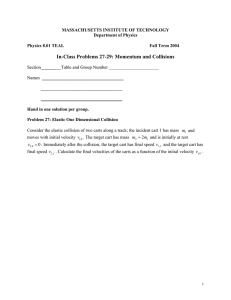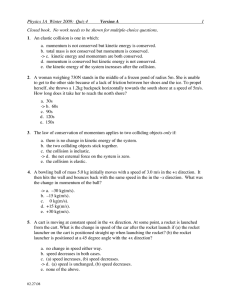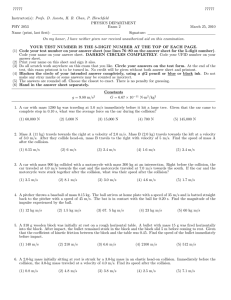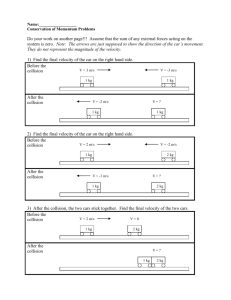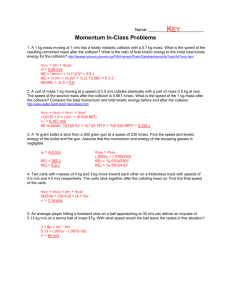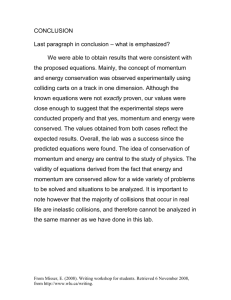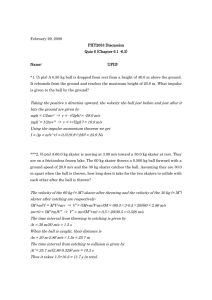0040 Lecture Notes - Mechanics FRQ #1 Solutions
advertisement
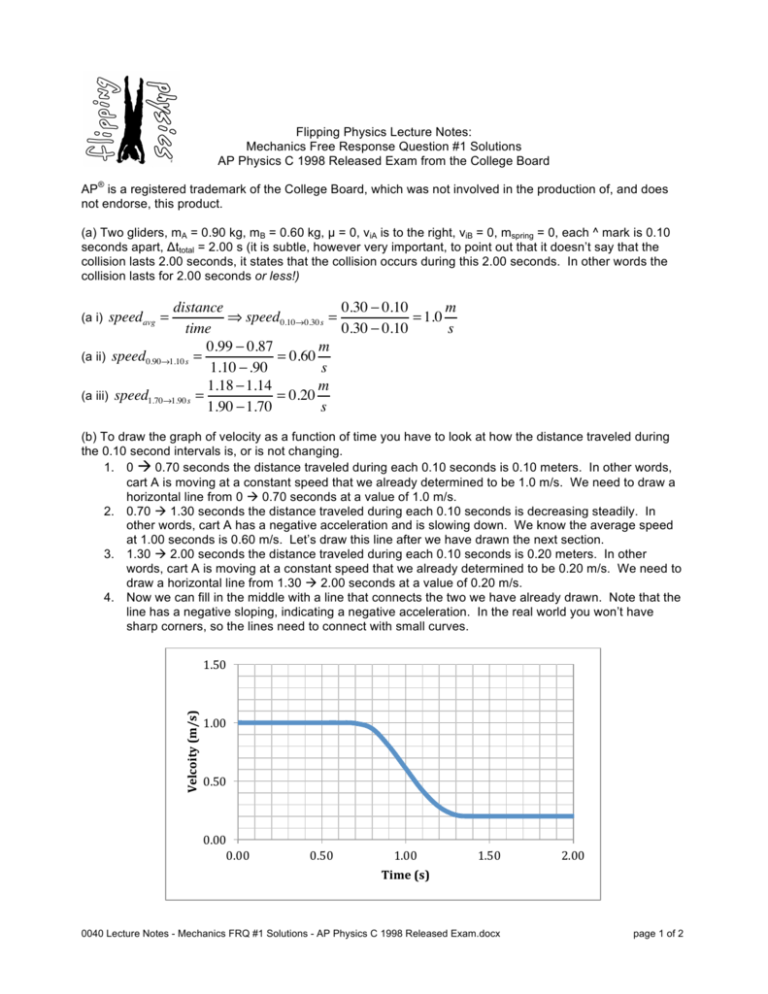
Flipping Physics Lecture Notes: Mechanics Free Response Question #1 Solutions AP Physics C 1998 Released Exam from the College Board ® AP is a registered trademark of the College Board, which was not involved in the production of, and does not endorse, this product. (a) Two gliders, mA = 0.90 kg, mB = 0.60 kg, µ = 0, viA is to the right, viB = 0, mspring = 0, each ^ mark is 0.10 seconds apart, Δttotal = 2.00 s (it is subtle, however very important, to point out that it doesn’t say that the collision lasts 2.00 seconds, it states that the collision occurs during this 2.00 seconds. In other words the collision lasts for 2.00 seconds or less!) distance 0.30 − 0.10 m ⇒ speed0.10→0.30s = = 1.0 time 0.30 − 0.10 s 0.99 − 0.87 m = 0.60 (a ii) speed0.90→1.10s = 1.10 −.90 s 1.18 −1.14 m = 0.20 (a iii) speed1.70→1.90s = 1.90 −1.70 s (a i) speedavg = (b) To draw the graph of velocity as a function of time you have to look at how the distance traveled during the 0.10 second intervals is, or is not changing. 1. 0 à 0.70 seconds the distance traveled during each 0.10 seconds is 0.10 meters. In other words, cart A is moving at a constant speed that we already determined to be 1.0 m/s. We need to draw a horizontal line from 0 à 0.70 seconds at a value of 1.0 m/s. 2. 0.70 à 1.30 seconds the distance traveled during each 0.10 seconds is decreasing steadily. In other words, cart A has a negative acceleration and is slowing down. We know the average speed at 1.00 seconds is 0.60 m/s. Let’s draw this line after we have drawn the next section. 3. 1.30 à 2.00 seconds the distance traveled during each 0.10 seconds is 0.20 meters. In other words, cart A is moving at a constant speed that we already determined to be 0.20 m/s. We need to draw a horizontal line from 1.30 à 2.00 seconds at a value of 0.20 m/s. 4. Now we can fill in the middle with a line that connects the two we have already drawn. Note that the line has a negative sloping, indicating a negative acceleration. In the real world you won’t have sharp corners, so the lines need to connect with small curves. Velcoity (m/s) 1.50 1.00 0.50 0.00 0.00 0.50 1.00 1.50 2.00 Time (s) 0040 Lecture Notes - Mechanics FRQ #1 Solutions - AP Physics C 1998 Released Exam.docx page 1 of 2 (c i) During this collision all forces are internal, therefore the net force on the system is zero, therefore momentum is conserved. ! ! ∑p =∑p i f ! ! ! ! ! ! ! ! ⇒ pAi + pBi = pAf + pBf ⇒ mA vAi + mB vBi = mA vAf + mB vBf 0.9 − 0.18 m ! ! ! ⇒ ( 0.9 ) (1) + ( 0.6 ) ( 0 ) = ( 0.9 ) ( 0.2 ) + ( 0.6 ) vBf ⇒ 0.9 = 0.18 + 0.6 vBf ⇒ vBf = = 1.2 0.6 s (c ii) This is very similar to part (b) in that there are three parts. Part 1 with a constant velocity of zero, part 3 with a final velocity of 1.2 m/s and part 2 in the middle where cart B accelerates from 0 to 1.2 m/s. Velocity (m/s) 1.50 1.00 0.50 0.00 0.00 0.50 1.00 1.50 2.00 Time (s) (d i) During an elastic collision Kinetic Energy of the system is conserved. You can see in the graph that before and after the collision the amount of Kinetic Energy is constant and has a value of Ko. Therefore, this is an elastic collision. (d ii) During the collision some of the Kinetic Energy is converted to elastic potential energy in the spring. At 1.0 seconds the spring is at its maximum compression and has the most Elastic Potential Energy, therefore, because Mechanical Energy is Conserved during this collision, the Kinetic Energy of the system is at its minimum. Notes about the published solutions: (b) The curves between the three parts were not required. (b) & (c ii) The graphs. For each one you could have drawn both constant velocity parts and completely messed up the acceleration parts and still gotten 2 out of 3 points. In other words, answer as much of each problem as you can. (c i) You could also have recognized from part (d) that the kinetic energy of the system was conserved and solved the problem using that. However, if you move linearly through the problem you probably wouldn’t notice that. (d) Even if you have no clue, you get 1 out of 2 points for the Yes/No answer. In other words, if there is a Yes/No question on the test, even if you have no clue, GUESS!! You stand a 50% chance of getting 1 point. page 2 of 2



